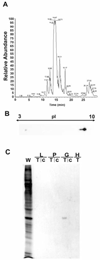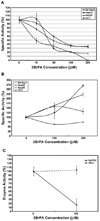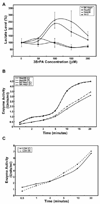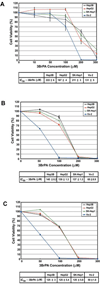Glyceraldehyde-3-phosphate dehydrogenase (GAPDH) is pyruvylated during 3-bromopyruvate mediated cancer cell death
- PMID: 20044597
- PMCID: PMC3743725
Glyceraldehyde-3-phosphate dehydrogenase (GAPDH) is pyruvylated during 3-bromopyruvate mediated cancer cell death
Abstract
Background: The pyruvic acid analog 3-bromopyruvate (3BrPA) is an alkylating agent known to induce cancer cell death by blocking glycolysis. The anti-glycolytic effect of 3BrPA is considered to be the inactivation of glycolytic enzymes. Yet, there is a lack of experimental documentation on the direct interaction of 3BrPA with any of the suggested targets during its anticancer effect.
Methods and results: In the current study, using radiolabeled ((14)C) 3BrPA in multiple cancer cell lines, glyceraldehyde-3-phosphate dehydrogenase (GAPDH) was identified as the primary intracellular target of 3BrPA, based on two-dimensional (2D) gel electrophoretic autoradiography, mass spectrometry and immunoprecipitation. Furthermore, in vitro enzyme kinetic studies established that 3BrPA has marked affinity to GAPDH. Finally, Annexin V staining and active caspase-3 immunoblotting demonstrated that apoptosis was induced by 3BrPA.
Conclusion: GAPDH pyruvylation by 3BrPA affects its enzymatic function and is the primary intracellular target in 3BrPA mediated cancer cell death.
Figures








Similar articles
-
Human hepatocellular carcinoma in a mouse model: assessment of tumor response to percutaneous ablation by using glyceraldehyde-3-phosphate dehydrogenase antagonists.Radiology. 2012 Mar;262(3):834-45. doi: 10.1148/radiol.11111569. Radiology. 2012. PMID: 22357885 Free PMC article.
-
The pyruvic acid analog 3-bromopyruvate interferes with the tetrazolium reagent MTS in the evaluation of cytotoxicity.Assay Drug Dev Technol. 2010 Apr;8(2):258-62. doi: 10.1089/adt.2009.0226. Assay Drug Dev Technol. 2010. PMID: 20085459
-
Science to practice: what do molecular biologic studies in rodent models add to our understanding of interventional oncologic procedures including percutaneous ablation by using glyceraldehyde-3-phosphate dehydrogenase antagonists?Radiology. 2012 Mar;262(3):737-9. doi: 10.1148/radiol.11112716. Radiology. 2012. PMID: 22357877 Free PMC article.
-
Anticancer efficacy of the metabolic blocker 3-bromopyruvate: specific molecular targeting.Anticancer Res. 2013 Jan;33(1):13-20. Anticancer Res. 2013. PMID: 23267123 Review.
-
Glyceraldehyde-3-phosphate dehydrogenase: a promising target for molecular therapy in hepatocellular carcinoma.Oncotarget. 2012 Sep;3(9):940-53. doi: 10.18632/oncotarget.623. Oncotarget. 2012. PMID: 22964488 Free PMC article. Review.
Cited by
-
Metabolic perturbation sensitizes human breast cancer to NK cell-mediated cytotoxicity by increasing the expression of MHC class I chain-related A/B.Oncoimmunology. 2015 Jan 14;4(3):e991228. doi: 10.4161/2162402X.2014.991228. eCollection 2015 Mar. Oncoimmunology. 2015. PMID: 25949910 Free PMC article.
-
Effect of 3-bromopyruvate and atovaquone on infection during in vitro interaction of Toxoplasma gondii and LLC-MK2 cells.Antimicrob Agents Chemother. 2015 Sep;59(9):5239-49. doi: 10.1128/AAC.00337-15. Epub 2015 Jun 15. Antimicrob Agents Chemother. 2015. PMID: 26077255 Free PMC article.
-
Anticancer agents that counteract tumor glycolysis.ChemMedChem. 2012 Aug;7(8):1318-50. doi: 10.1002/cmdc.201200176. Epub 2012 Jun 8. ChemMedChem. 2012. PMID: 22684868 Free PMC article. Review.
-
Tumor glycolysis as a target for cancer therapy: progress and prospects.Mol Cancer. 2013 Dec 3;12:152. doi: 10.1186/1476-4598-12-152. Mol Cancer. 2013. PMID: 24298908 Free PMC article. Review.
-
The bioenergetic signature of isogenic colon cancer cells predicts the cell death response to treatment with 3-bromopyruvate, iodoacetate or 5-fluorouracil.J Transl Med. 2011 Feb 8;9:19. doi: 10.1186/1479-5876-9-19. J Transl Med. 2011. PMID: 21303518 Free PMC article.
References
-
- Warburg O. On the origin of cancer cells. Science. 1956;123(3191):309–314. - PubMed
-
- Chen Z, Lu W, Garcia-Prieto C, Huang P. The Warburg effect and its cancer therapeutic implications. J Bioenerg Biomembr. 2007;39(3):267–274. - PubMed
-
- Bonnet S, Archer SL, Allalunis-Turner J, Haromy A, Beaulieu C, Thompson R, Lee CT, Lopaschuk GD, Puttagunta L, Bonnet S, Harry G, Hashimoto K, Porter CJ, Andrade MA, Thebaud B, Michelakis ED. A mitochondria-K+ channel axis is suppressed in cancer and its normalization promotes apoptosis and inhibits cancer growth. Cancer Cell. 2007;11:37–51. - PubMed
-
- Weindruch R, Keenan KP, Carney JM, Fernandes G, Feuers RJ, Floyd RA, Halter JB, Ramsey JJ, Richardson A, Roth GS, Spindler SR. Caloric restriction mimetics: metabolic interventions. J Gerontol A Biol Sci Med Sci. 2001;56(1):20–33. - PubMed
-
- Maher JC, Krishan A, Lampidis TJ. Greater cell cycle inhibition and cytotoxicity induced by 2-deoxy-D-glucose in tumor cells treated under hypoxic vs. aerobic conditions. Cancer Chemother Pharmacol. 2004;53:116–122. - PubMed
Publication types
MeSH terms
Substances
Grants and funding
LinkOut - more resources
Full Text Sources
Other Literature Sources
Medical
Research Materials
